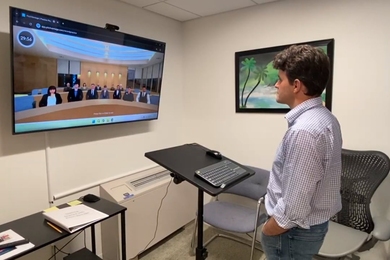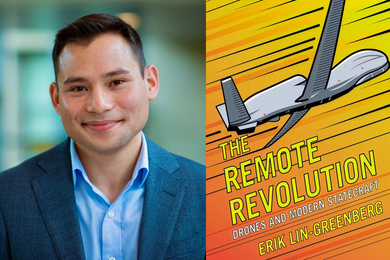Two major laboratories at MIT are merging: the Laboratory for Computer Science and the Artificial Intelligence Laboratory.
The joint laboratory, called the New Laboratory for Computer Science and Artificial Intelligence, will be the largest laboratory on the MIT campus in terms of research volume (only Lincoln Lab, headquartered in Lexington, is larger), and will be home to more than 750 students, faculty and staff.
"This is a very important reorganization, and I'm confident that it will serve our intellectual and educational goals well," said President Charles M. Vest. "I truly admire the MIT faculty for its ability to evolve and change as needed to maintain leadership in areas of research that are a fundamental part of MIT."
The announcement was made on May 23 at a two-day symposium celebrating the centennial of the Department of Electrical Engineering and Computer Science, which is the academic home to most of the members of both laboratories.
Professor Rodney Brooks, director of the Artificial Intelligence Laboratory (AI Lab), will serve as the new lab's director. Victor Zue, director of the Laboratory for Computer Science (LCS), a position he has held since the death of long-time director Michael Dertouzos in 2001, will serve as co-director of the lab.
Both the AI Lab and the LCS have shared the same Tech Square building for more than 30 years, but intellectually and culturally they evolved in very different directions. The impetus for the merger was increased collaboration across the two laboratories--most recently, both joined forces with six companies to launch the Oxygen project on human-centered computing--and a recognition that the historical, intellectual and administrative divisions between the two labs no longer made sense.
"Despite their long histories and the individual recognition of the two labs in the larger world, the lab members felt that the benefits of the merger outweigh any costs," said Dean of Engineering Thomas Magnanti.
The LCS was founded in 1963 with funds from the Department of Defense, in part as a reaction to the surprise launch of the Soviet satellite Sputnik. Originally known as Project MAC (Multiple Access Computing and Machine-Aided Cognition), its mission was to develop a computer system accessible to a large number of people, and to exploit the computer as an aid to research and education.
LCS members and alumni have been instrumental in the development of the ARPANet, the Internet, Ethernet, the World Wide Web, time-shared computers, RSA encryption and dozens of other technologies. More than 4,000 researchers and students have contributed to the lab's work over the last four decades, and its members have founded over four dozen companies including 3Com, Lotus and Akamai.
The AI Lab was founded as the AI project in 1959, and was briefly a part of Project MAC and LCS before splitting off entirely in 1970. Its goal has always been to understand the nature of intelligence, of which vision, robotics and language are key, and to engineer systems that exhibit intelligence.
Over the last few years, significant applications have built on the AI Lab's robotics, vision, language and circuit design technology. During the last decade, the lab pioneered new methods for image-guided surgery, wired the White House, made haptic interfaces a reality, produced new generations of microdisplays, pioneered natural-language-based web access, developed bacterial robots, and developed behavior-based robots that are now used for planetary exploration, military reconnaissance and in home consumer devices. Companies that have been spun out of the AI Lab include Imagen, iRobot, SensAble Technologies and Thinking Machines.
The new lab is likely to be organized around significant computer science research themes such as networking, human-computer interaction, bioinformatics, machine learning and traditional robotics, among others.
The new lab will officially open on July 1, exactly 40 years after the founding of Project MAC. Next winter, it will move into a new home, the Ray and Maria Stata Center for Computer, Information and Intelligence Sciences, which will also house the Laboratory for Information Decision Systems and the Department of Linguistics and Philosophy.
A version of this article appeared in MIT Tech Talk on June 4, 2003.






